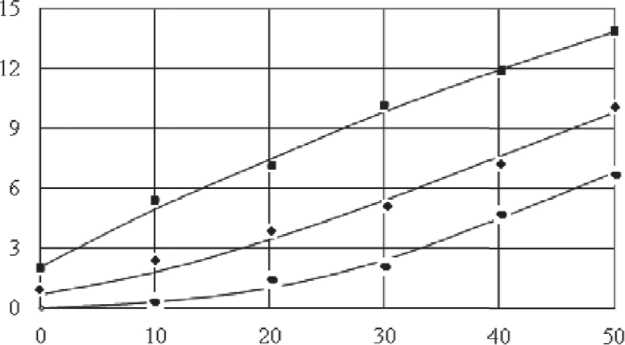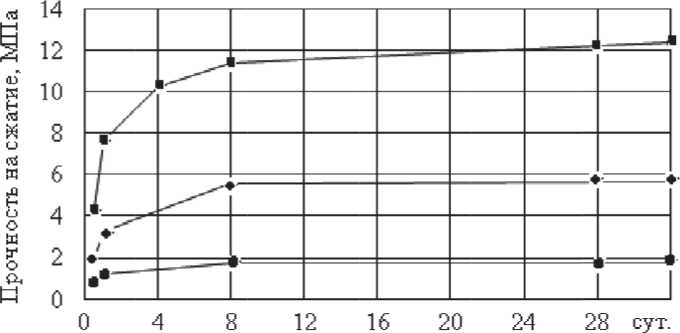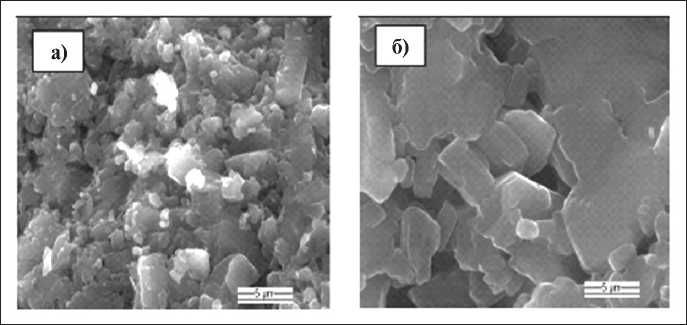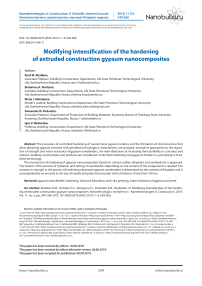Modifying intensification of the hardening of extruded construction gypsum nanocomposites
Автор: Khalikov R.M., Sinitsina E.A., Silantyeva E.I., Pudovkin A.N., Nedoseko I.V.
Журнал: Nanotechnologies in Construction: A Scientific Internet-Journal @nanobuild-en
Рубрика: The elaboration of the theory of the formation strength and impermeability of nanostructured systems
Статья в выпуске: 5 Vol.11, 2019 года.
Бесплатный доступ
The processes of controlled hardening of nanomineral gypsum binders and the formation of microstructure that allow obtaining gypsum concrete with specified technological characteristics are analyzed. Innovative approaches to the regulation of strength and water resistance of gypsum nanobinders, the main directions of increasing their durability in concretes and mortars, building constructions and products are considered. Controlled hardening nanogypsum binders is a promising 3-D additive technology. The mechanism of hardening of gypsum nanocomposites based on calcium sulfate dihydrate and semihydrate is proposed. The kinetics of the process of hydration and setting of nanobinders depending on the content of the components is studied. The increase in strength in the process of hardening of pressed gypsum nanobinders is determined by the content of dihydrate and is accompanied by an increase in the size of needle and plate microcrystals with a thickness of less than 100 nm.
Gypsum nanobinder, hardening, structure formation, semi-dry pressing, water resistance of gypsum concrete
Короткий адрес: https://sciup.org/142227462
IDR: 142227462 | УДК: 666.914: 691.5 | DOI: 10.15828/2075-8545-2019-11-5-549-560
Текст научной статьи Modifying intensification of the hardening of extruded construction gypsum nanocomposites
Modifying intensification of the hardening of extruded construction gypsum nanocomposites by Khalikov R.M., Sinitsina E.A., Silantyeva E.I., Pudovkin A.N., Nedoseko I.V. is licensed under a Creative Commons Attribution 4.0 International License.
Based on a work at a>.
Permissions beyond the scope of this license may be available at .
Modifying intensification of the hardening of extruded construction gypsum nanocomposites by Khalikov R.M., Sinitsina E.A., Silantyeva E.I., Pudovkin A.N., Nedoseko I.V. is licensed under a Creative Commons Attribution 4.0 International License.
Based on a work at a>.
Permissions beyond the scope of this license may be available at .
С тройматериалы на основе бесклинкерных гипсовых вяжущих отличаются малой энергозатратностью производства (в десятки раз меньше чем портландцемент), достаточной звуко–, теплоизоляцией и другими технологическими преимуществами. Разработка модифицированных нанокомпозиционных прессованных гипсовых вяжущих, обеспечивающих получение изделий с высокими физико-механическими, эксплуатационными и технико-экономическими показателями, остается актуальной задачей.
Данная статья нацелена на исследование кинетики регулируемого твердения гипсовых нановяжущих.
ОСНОВНАЯ ЧАСТЬ
Для решения технологических задач повышения эффективности процессов твердения [1] гипсона-нобетонов необходимо управлять кинетикой схватывания и набора прочности. Физико-химические особенности твердения гипсовых стройматериалов зависят, прежде всего, от технологии производства сырьевых компонентов.
Запасы гипсовых минералов в России практически неисчерпаемы (только в Республике Башкортостан на разведанных месторождениях они составляют свыше 400 млн. тонн), имеется также большое количество гипсосодержащих отходов, которые пригодны для производства материалов различно- го назначения на основе гипса. В настоящее время ежегодно в мире вырабатывается около 250 млн. т гипсовых материалов на основе природного сырья и техногенных отходов [2].
Основой производства гипсовых нановяжущих является термообработка гипсового камня, при которой происходят поэтапные физико-химические процессы обезвоживания (дегидратация). По технологии производства различают низкообжиговые (до 250оС), высокообжиговые (от 600оС до 1000оС) и безобжиговые гипсовые вяжущие. Степень дегидратации CaSO4•2 H2O (дигидрата сульфата кальция) зависит от температуры, условий и длительности тепловой обработки. При низкотемпературной автоклавной термообработке (95–100оC) образуется α-модификация CaSO4•0,5 H2O (более корректно 2CaSO4•H2O). α-Модификация полугидрата сульфата кальция состоит из крупных плотных кристаллов, которые используются в технологическом производстве высокопрочного гипса (15–20 МПа).
При удалении гидратной воды в открытых технологических аппаратах из кристаллов CaSO4•2 H2O в виде пара происходит его диспергирование и разрыхление кристаллической решетки, при этом образуется β-форма полуводного CaSO4•0,5 H2O. Микрокристаллы β-полугидрата сульфата кальция мелкие, дефективно сформированы, поэтому гипсовые вяжущие получаются значительными вариациями дисперсности, водопотребности, пористости и сниженными значениями прочности.
THE ELABORATION OF THE THEORY OF THE FORMATION STRENGTH AND IMPERMEABILITY OF NANOSTRUCTURED SYSTEMS РАЗРАБОТКА ТЕОРИИ ФОРМИРОВАНИЯ ПРОЧНОСТИ И НЕПРОНИЦАЕМОСТИ НАНОСТРУКТУРИРОВАННЫХ СИСТЕМ
Низкообжиговые гипсовые вяжущие быстро схватываются и твердеют, состоят преимущественно из β-модификации CaSO4•0,5 H2O и являются основой строительного и формовочного гипсовых вяжущих. Высокообжиговые гипсовые нановяжущие отвердевают медленнее, состоят преимущественно из ангидрита (сульфата кальция CaSO4) и 3–5% оксида кальция и образуют водостойкие нанокомпозиты. Безобжиговые гипсовые вяжущие получают при тонком измельчении природных или искусственных разновидностей сульфата кальция, и это позволяет уменьшить энергозатраты на переработку исходного сырья.
Процессы гидратации и схватывания нанокомпозитов гипсовых вяжущих зависят [3] от множества разнообразных факторов: соотношения гипсового компонента–воды; интенсивности и температуры смешения; тонкости помола и т.п. Физико-химические процессы твердения полугидрата сульфата кальция (так же как и других гипсовых нановяжущих) происходит в три стадии:
-
• растворение микрочастиц полугидрата в воде и образование его насыщенного раствора; гипсовое нановяжущее пластично;
-
• взаимодействие воды с полугидратом сульфата кальция, что приводит к образованию дигидрата CaSO4•2H2O в виде ультрадисперсных кристаллических микрочастиц (дигидрат значительно менее растворим в воде (2 г/л) по сравнению с CaSO4•0,5 H2O (8 г/л) и формированию коллоидной наносистемы за счет Ван-дер-Ваальсовых взаимодействий и сопровождается запуском гелеобразного твердения;
-
• перекристаллизация тонкодисперсных частичек дигидрата сульфата кальция с топохимическим формированием более крупных кристаллов и постепенным срастанием в кристаллические сростки, что обеспечивает твердение и набор прочности гипсовых нанокомпозитов.
В зависимости от сроков схватывания гипсовые вяжущие варьируют от быстротвердеющих (начало отверждения не ранее 2 мин., конец не позднее 15 мин.) до медленнотвердеющих (начало твердения не ранее 20 мин., а конец не нормируется). Одним из эффективных способов регулирования сроков схватывания гипсовых вяжущих является применение соответствующих нанодобавок. Технология производства многофазового гипсового нановяжущего с преимущественным содержанием ангидрита обеспечивает замедленные сроки схватывания.
Стехиометрическое соотношение вода-гипсо-вое вяжущее при гидратации CaSO4•0,5H2O в дигидрат равно 0,18: значит, требуется добавить около 18% воды. Добавочное количество воды (до 30–40%) необходимо прибавить для производства удобнофор- муемой пасты гипсовой нановяжущей. На кинетику схватывания гипсовых нановяжущих также влияют тонкость помола, длительность хранения исходного сырья и другие факторы [4].
Теоретические и экспериментальные исследования [5–9] механизмов твердения гипсовых нановяжущих показали, что формирование кристаллизационной наноструктуры происходит при выполнении следующих условий:
-
• микрочастицы дисперсной фазы должны находиться на достаточно малом расстоянии hк , при котором возможно образование кристаллизационных наноконтактов между ними;
-
• концентрация растворенного вещества в дисперсной среде должна быть больше растворимости кристаллогидрата, т. е. система должна быть метастабильной. Чем выше пересыщение раствора, тем больше может быть расстояние между срастающимися частицами гидрата, при котором возможно образование кристаллизационной наноструктуры.
Расстояние между микрочастицами hк , обеспечивающее формирование нанокристаллизационных контактов по данным работы [5], должно быть равно ^3δ0 (δ0 – межмолекулярное расстояние). Сблизить кристаллогидратные частицы дигидрата гипса до требуемого расстояния ординарными технологическими приемами, в частности, по литьевой технологии не удается, поэтому разрабатываются нетривиальные способы формования. При прессовании полусухих смесей сблизить частицы дигидрата гипса на расстояние, необходимое для образования кристаллизационной наноструктуры, также затруднено, что обусловлено низким водосодержанием смеси и невысоким давлением прессования. Следовательно, для подобных гипсовых нановяжущих необходимо повысить пересыщение жидкой фазы дигидратом, т.е. выполнить второе условие возникновения кристаллогидратной структуры, а этого можно достичь введением в композицию некоторой массовой доли CaSO4•2H2O.
Рассмотрим механизм твердения нановяжущей на примере гипсовой композиции, твердая фаза которой состоит из дигидратного (ДГ) и полуги-дратного (ПГ) сульфата кальция. При затворении водой ПГ начинает интенсивно гидратироваться и растворяться: в дисперсной системе достаточно быстро создается пересыщенная концентрация ДГ в виде зародышевых кристаллогидратов с размером ≈2 нм. Однако пространственная кристаллогидратная наноструктура может не формироваться, если первоначальное расстояние между нанокластерами ДГ слишком велико (больше 10 нм), т.е. исходные компоненты недостаточно уплотнены, а количество нановяжущего ПГ недостаточно для того, чтобы при
THE ELABORATION OF THE THEORY OF THE FORMATION STRENGTH AND IMPERMEABILITY OF NANOSTRUCTURED SYSTEMS РАЗРАБОТКА ТЕОРИИ ФОРМИРОВАНИЯ ПРОЧНОСТИ И НЕПРОНИЦАЕМОСТИ НАНОСТРУКТУРИРОВАННЫХ СИСТЕМ его гидратации зазор между кристаллами ДГ уменьшился до критического.
После окончания процесса гидратации ПГ сульфата кальция в первые часы твердения наступает вторая стадия отверждения нанокомпозиции: к этому моменту времени сформировалась первичная трехмерная наноструктура, обладающая начальной прочностью, но с недостаточной водостойкостью. В дальнейшем происходит упрочнение существующей первичной наноструктуры, а также рост числа наноконтактов кристаллизации между несвязанными микрокристаллами и их обрастания. Вторая стадия упрочнения кристаллогидратных наноструктур протекает медленно в течение нескольких месяцев, в зависимости от условий твердения гипсовых нановяжущих [10].
Исследования микроструктуры гипсовых нановяжущих показывают, что между пластинчатыми с толщиной менее 100 нм игольчатыми кристаллами CaSO4•2H2O разнообразной формы и размеров в твердофазовом состоянии имеются микрополости и микропоры [11]. Сформированная наноструктура кристаллической решетки дигидрата сульфата кальция слоистая: прослойка из ионов Са2+ и сульфатных тетраэдров SO42– (соединенные прочными ионными связями) чередуется слоем молекул воды. Параметры наноструктуры кристаллов CaSO4•2H2O следующие: а 0 = 0,57 нм, b 0 = 1,52 нм, с 0 = 0,63 нм.
Для регулирования скорости твердения (замедления в начале процесса, ускорения при завершении набора прочности) компонентов 3D-технологий в гипсовую нанокомпозицию добавляют разнообразные добавки: например, 0,05% лимонная кислота
(полидентантный ингибитор) замедляет схватывание на 30 мин. Разнообразные замедлители твердения понижают скорость растворения полугидрата гипса, следовательно, уменьшают концентрацию выпадающих в осадок кристаллогидратов. В частности, ингибирующее действие клеев и поверхностно активных веществ на кинетику схватывания объясняется тем, что они формируют устойчивые коллоидные наночастицы, которые задерживают процесс кристаллизации дигидрата гипса.
Кинетику твердения нановяжущих и образование первичной наноструктуры, а также влияния дигидрата гипса изучали путем формования и испытания образцов различного состава. Для этого изготовили образцы на основе марки гипса Г-4:
гипсовое ПГ нановяжущее Г-4(-Б-II) – ДГ (Sуд. ≈ 3000 см2/г);
гипсовое ПГ нановяжущее Г-4(-Б-II) – доломитовая мука (Sуд. ≈ 2600 см2/г);
гипсовое ПГ нановяжущее Г-4(-Б-II) – кварцевый песок.
Содержание ПГ нановяжущего изменялось от 0 до 50%, водотвердое отношение – 0,22…0,17. Приготовленные образцы цилиндрической формы прессовали под давлением 20 МПа в течение 30 с и испытывали на прочность при сжатии в возрасте 1 сут. твердения при относительной влажности воздуха φ = 60±10% и температуры tо = 20±2оС. Результаты экспериментальных исследований образцов на основе гипсовых нановяжущих на прочность представлены на рис. 1.
Из рисунка 1 заметно, что дигидратный гипс достаточно активно участвует в формировании пер-


Содержание гипсового нановяжущего, %
—■— - гипсово е вяжущее - двуводный гипс;
—♦— - гипсовое вяжущее - доло китовая мука;
—*— - гипсово е вяжущее - кварцевый песок.

■ - гипсовое вяжущее - двуводныи гипс;
■♦—- гипсовое вяжущее - доломитовая мука; ।— гипсовое вяжущее - кварцевый песок.
Рис. 1. Динамика роста прочности образцов различного состава в зависимости от содержания гипсового нановяжущего в возрасте 1 сут.
Рис. 2. Изменение прочности во времени прессованных образцов различного состава при содержании гипсового нановяжущего 20%
THE ELABORATION OF THE THEORY OF THE FORMATION STRENGTH AND IMPERMEABILITY OF NANOSTRUCTURED SYSTEMS РАЗРАБОТКА ТЕОРИИ ФОРМИРОВАНИЯ ПРОЧНОСТИ И НЕПРОНИЦАЕМОСТИ НАНОСТРУКТУРИРОВАННЫХ СИСТЕМ

Рис. 3. Микроструктура прессованных нанокомпозитных гипсовых матриц.
Время твердения: а) – 1 сут., б) – 8 сут.
вичной наноструктуры. При наличии в системе ДГ даже при небольшом содержании ПГ (не более 10%) образуется трехмерная нанокристаллизационная структура с достаточно высокой прочностью.
Для изучения безгидратационного набора прочности затвердевшие образцы на основе гипсовых нановяжущих хранились в течение месяца при tо = 20±2оС и относительной влажности атмосферы φ = 60±10%. Кинетика изменения прочности на сжатие нанокомпозитных образцов приведена на рис. 2: заметный рост прочности на сжатие происходит в первые 4 сутки.
Микроструктура гипсовых нанокомпозитов исследована на растровом электронном микроскопе JEOL JSM-6610L. Электронномикроскопические снимки показывают (рис. 3) увеличение размеров микрокристаллов в течение 8 суток.
На базе данных лабораторных опытов была разработана технология получения мелкоштучных стеновых и перегородочных изделий, которая была апробирована в опытно-промышленных условиях. За счет использования технологий полусухого прессования и вибропрессования получены стеновые перегородочные стройматериалы с достаточной прочностью. Использование наночастиц техногенных отходов [12–14] позволяет ускорить кинетику набора прочности, повысить марку по водонепроницаемости и улучшить эксплуатационные характеристики композиционных гипсовых вяжущих. В работе [15] подробно рассмотрена технология получения мелкоштучных стеновых изделий полусухим прессованием на основе техногенного дигидрата фосфогипса.
Рассмотрение структурообразования и твердения фосфогипсовых стройматериалов с позиции фрактальной концепции корректно моделируется в виде мультифрактальных нанокластеров дигидрата суль- фата кальция размерами несколько десятков нанометров [16]. Фосфогипсовая нанокомпозиция с отходами производства соды твердеет за счет комплексных реакций с образованием гидросульфоалюминатов и гидросиликатов кальция. В статье [17] предложен метод количественного анализа изображений микроструктуры наномодифицированного композита, основанный на выполнении двоичной декомпозиции. Средние значения фрактальной размерности для эмпирических изображений микроструктуры составляют 1,63 (оптическая микроскопия) и 1,76 (сканирующая зондовая микроскопия).
При механоактивации высокопрочных гипсов [18] целесообразно ввести в сухую строительную смесь «FREM NANOGIPS»: это дает снижение водогипсового отношения и повышение в 3–6 раз прочностных характеристик получаемых наноком-позитных гипсовых изделий и материалов; позволяет регулировать время схватывания, усиливает водостойкость, а также поверхностную твердость и адгезию [19] к различным твердофазным материалам. Авторами статьи [20] установлено, что при модифицировании 0,18% многослойными углеродными нанотрубками наблюдается прирост прочности на сжатие гипса до 29%.
Инновационные материалы на базе гипсовых на-нокомпозитных вяжущих (сухие штукатурные и шпаклевочные смеси) созданы модификацией 0,25–1% поливинилацетатными редиспергируемыми полимерами [21]. Модифицированные гипсовые сухие смеси обладают уникальными характеристиками: возможностью регулирования сроков схватывания в широких диапазонах, достаточной прочностью, водостойкостью и др.
Следует отметить, что регуляция твердения гипсовых вяжущих считается перспективным при конструировании исходных компонентов 3D-технологий
THE ELABORATION OF THE THEORY OF THE FORMATION STRENGTH AND IMPERMEABILITY OF NANOSTRUCTURED SYSTEMS РАЗРАБОТКА ТЕОРИИ ФОРМИРОВАНИЯ ПРОЧНОСТИ И НЕПРОНИЦАЕМОСТИ НАНОСТРУКТУРИРОВАННЫХ СИСТЕМ
-
[22] . Аддитивные технологии представляют собой послойное добавление материала по компьютерной 3D-модели [23], и в настоящее время проектировщики в стройиндустрии все больше используют технологии 3D-печати, что обеспечивает быстроту возведения малоэтажных зданий со сложной конструкцией. Эффективным подходом усиления эксплуатационных характеристик строительных нанокомпозитов для 3D аддитивных технологий на базе гипсовых вяжущих является реализация регулируемого твердения с минеральными добавками.
ВЫВОДЫ
Таким образом, нарастание прочности в процессе твердения гипсовых нановяжущих определяется химико-минералогическим составом исходных сырьевых компонентов и идет параллельно изменению их микроструктуры. Технологические свойства гипсовых нанокомпозитов: сроки схватывания, водостойкость, прочность и др. можно регулировать, изменяя соотношение отдельных компонентов и введением техногенных наномодификатов.
Список литературы Modifying intensification of the hardening of extruded construction gypsum nanocomposites
- Chernishov E.M., Artamonova O.V., Slavcheva G.S. Nanotechnological applied tasks of the increase in the efficiency of the hardening processes of cement concrete. Nanotehnologii v stroitel’stve = Nanotechnologies in Construction. 2017, Vol. 9, no. 1, pp. 25–41. DOI: dx.doi.org/10.15828/2075-8545-2017-9-1-25-41. (In Russian).
- Belov V.V., Buryanov A.F., Yakovlev G.I. et al. Modification of the structure and properties of building composites based on calcium sulfate. Moscow: De Nova. 2012. 196 р. (In Russian).
- Padevět P., Tesárek P., Plachý T. Evolution of mechanical properties of gypsum in time. International Journal of Mechanics. 2011. Vol. 5, no 1. P. 1–9.
- Gypsum materials and products (production and use). Handbook / Ed. A.V. Ferronskaya. Moscow: Publ. ABU, 2004. 485 p. (In Russian).
- Polak A.F., Babkov V.V., Andreeva E.P. Hardening mineral binders. Ufa: Bash. Publ. House, 1990. 215 p. (In Russian).
- Klimenko V.G. Multiphase gypsum binders. Belgorod: BSTU named after V.G. Shukhov, 2010. 198 p. (In Russian).
- Petropavlovskaya V.B., Belov V.V., Novichenkova T.B. Low-energy-intensive gypsum building composites. Tver: TSTU, 2014. 136 p. (In Russian).
- Yu Q.L., Brouwers H.J.H. Microstructure and mechanical properties of β-hemihydrate produced gypsum: An insight from its hydration process. Constr. Build. Mater. 2011. Vol. 25. Р. 3149–3157.
- Mirsaev R.N., Babkov V.V., Nedoseko I.V. et al. Structural Formation and Hardening of Compressed Calcium Sulphate Dihydrate Compositions. Construction Materials. 2009. No. 6. Р. 6–9. (In Russian).
- Gaitova A.R., Akhmadullina I.I., Pechenkina T.V. et al. Nanostructural aspects of hydration and hardening of gypsum and gypsum-slag compositions based on two-water gypsum. Construction Materials. 2014. No. 1–2. P. 46–51. (In Russian).
- Tokarev Yu.V., Ginchitsky E.O., Yakovlev G.I. et al. Modification efficiency of gypsum binder with carbon nanotubes and additives of different dispersity. Construction Materials. 2015. No. 6. P. 84–87. (In Russian).
- Oratovska A.A., Sinitsyn D A., Galeeva L.S. et al. The use waste of production of sodium to obtain lime-containing binders and building materials on their basis. Construction Materials. 2012. No. 2. P. 52–53. (In Russian).
- Khezhev T.A., Pukharenko Yu.V., Khezhev Kh.A. et al. Fiber gypsum concrete composites with using volcanic tuff sawing waste. Journal of Engineering and Applied Sciences. 2018. Vol. 13, no. 8. Р. 2935–2946.
- Khalikov R. M., Ivanova O. V. Technological schemes of solution of ecological problems of regional production of materials. Nauka-Rastudent.ru. 2014. No. 3(03). P. 10. (In Russian).
- Mirsaev R.N., Babkov V.V., Yunusova S.S. et al. Phosphogypsum waste of the chemical industry in the production of wall products. Moscow: Chemistry, 2004. 176 p. (In Russian).
- Sinitsin D.A., Khalikov R.M., Bulatov B.G. et al. Technological approaches to directed structure formation of construction nanocomposites with increased corrosion resistance. Nanotehnologii v stroitel’stve = Nanotechnologies in Construction. 2019, Vol. 11, no. 2, pp. 153–164. – DOI: 10.15828/2075-8545-2019-11-2-153-164. (In Russian).
- Smirnov V.A., Korolev E.V., Danilov A.M. et al. Fractal analysis of the nano-modified composite microstructure. Nanotechnologies in construction. 2011. V. 3, no. 5, pp. 77–86. (In Russian).
- Kuzmina V.P. Mechanisms of nanoadditives influence on gypsum products. Nanotechnologies in construction. 2012. V. 4, no. 3, pp. 98–106. (In Russian).
- Mashukov N.I., Khalikov R.M., Kharaev A.M. Stabilization and modification of molecular structures. Saarbrucken: Palmarium Academic Publishing, 2014. 210 p. (In Russian).
- Chumak A.G., Derevyanko V.N., Petrunin S.Yu. et al. Structure and properties of a composite material based on gypsum binder and carbon nanotubes. Nanotechnologies in construction. 2013. V. 5, no. 2, pp. 27–37. (In Russian).
- Panferova A.Yu., Garkavi M.S. Modification of gypsum systems with small additions of polymers. Construction Materials. 2011. No. 6. Р. 8–9. (In Russian).
- Chernysheva N.V., Glagolev E.S., Lesovik V.S. et al. Effective composites employing fast-hardening gypsum cement binders for additive manufacturing. Advances in Engineering Research. 2017. V. 133. P. 135–141.
- Sergeeva O.Yu. Additive technologies and 3D modeling. Nanotehnologii v stroitel’stve = Nanotechnologies in construction. 2018. V. 10, no. 4, pp. 142–158. DOI: dx.doi. org / 10.15828 / 2075-8545-2018-10-4-142-158. (In Russian).


